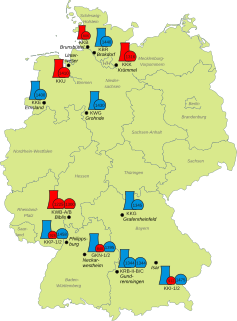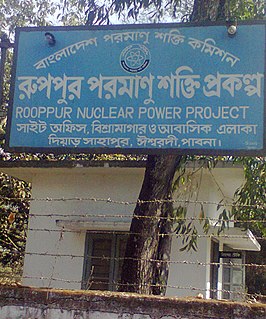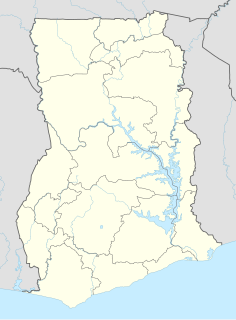There is one nuclear reactor in Ghana, the Ghana Research Reactor, located in Accra. In operation since 1994, it is used for research, medical, and industrial purposes, but not for generating electricity. [1]
The Ghana Atomic Energy Commission has been investigating the use of nuclear power and is a member of the International Nuclear Library Network. [2] The commission is working with the International Atomic Energy Agency to implement nuclear power in Ghana as part of a wider project, Sustainable Energy Development for Sub-Saharan Africa. [3] Ghana also has a Graduate School of Nuclear and Allied Sciences which trains undergraduate and postgraduate students in the techniques of nuclear science application in such areas as agriculture, medicine, and research. [4] Both of these organizations focus more on research and the one research reactor located in Ghana than on nuclear power.
The government of Ghana is committed to the development of nuclear power as an environmentally-friendly energy source, and as of 2020 is undertaking preparatory steps for nuclear energy generation. President John Agyekum Kufuor supported the future building of nuclear power plants, seeing it as part of a solution to the country's energy problems. He initiated a Nuclear Power Committee to study the issue. In 2011, the director of the National Nuclear Research Institute, Benjamin Nyarko, also said he believed nuclear power could prevent future energy crises. The ministry has created a section to co-ordinate activities on the nuclear power project. [5]
The Russian state-owned atomic energy corporation Rosatom signed a 'Memorandum of Understanding' with Ghana in August 2015 to develop a 1200 Megawatt reactor in Ghana- however, as the total energy production in the country at the time was only 2831MW, significant upgrades to the nation's energy grid would be necessary to accommodate it. [6] [7] In January 2017, the IAEA concluded an eight-day mission to Ghana to review the country's infrastructure and in preparation for selecting international vendors. [8] A follow-up mission in October 2019 concluded that significant progress had been made, and that Ghana would soon be ready to discuss its options with international partners. [9]

The International Atomic Energy Agency (IAEA) is an international organization that seeks to promote the peaceful use of nuclear energy, and to inhibit its use for any military purpose, including nuclear weapons. The IAEA was established as an autonomous organisation on 29 July 1957. Though established independently of the United Nations through its own international treaty, the IAEA Statute, the IAEA reports to both the United Nations General Assembly and Security Council.

Nuclear power is the use of nuclear reactions to produce electricity. Nuclear power can be obtained from nuclear fission, nuclear decay and nuclear fusion reactions. Presently, the vast majority of electricity from nuclear power is produced by nuclear fission of uranium and plutonium in nuclear power plants. Nuclear decay processes are used in niche applications such as radioisotope thermoelectric generators in some space probes such as Voyager 2. Generating electricity from fusion power remains the focus of international research.

Nuclear proliferation is the spread of nuclear weapons, fissionable material, and weapons-applicable nuclear technology and information to nations not recognized as "Nuclear Weapon States" by the Treaty on the Non-Proliferation of Nuclear Weapons, commonly known as the Non-Proliferation Treaty or NPT. Proliferation has been opposed by many nations with and without nuclear weapons, as governments fear that more countries with nuclear weapons will increase the possibility of nuclear warfare, de-stabilize international or regional relations, or infringe upon the national sovereignty of nation states.

Nuclear energy policy is a national and international policy concerning some or all aspects of nuclear energy and the nuclear fuel cycle, such as uranium mining, ore concentration, conversion, enrichment for nuclear fuel, generating electricity by nuclear power, storing and reprocessing spent nuclear fuel, and disposal of radioactive waste.

Research reactors are nuclear reactors that serve primarily as a neutron source. They are also called non-power reactors, in contrast to power reactors that are used for electricity production, heat generation, or maritime propulsion.
The Chashma Nuclear Power Plant, is a large commercial nuclear power plant located in the vicinities of Chashma colony and Kundian in Punjab in Pakistan.

As of 2017, nuclear power in Pakistan is provided by five commercial nuclear power plants. Pakistan is the first Muslim majority country in the world to construct and operate civil nuclear power plants. The Pakistan Atomic Energy Commission (PAEC), the scientific and nuclear governmental agency, is solely responsible for operating these power plants. As of 2018, the electricity generated by commercial nuclear power plants constitutes roughly 7.5% of electricity generated in Pakistan, Pakistan is not a party to the Nuclear Non-Proliferation Treaty but is a member of the International Atomic Energy Agency. Pakistan plans on constructing 32 nuclear power plants by 2050 and envision 40,000 MW of nuclear power generation.

The Armenian Nuclear Power Plant (ANPP), also known as the Metsamor Nuclear Power Plant, is the only nuclear power plant in the South Caucasus, located 36 kilometers west of Yerevan in Armenia. The ANPP complex consists of two VVER-440 Model V270 nuclear reactors, each capable of generating 407.5 megawatts (MW) of power, for a total of 815 MW. The plant supplied approximately 40 percent of Armenia's electricity in 2015.

Nuclear power is the fifth-largest source of electricity in India after coal, gas, hydroelectricity and wind power. As of November 2020, India has 23 nuclear reactors in operation in 7 nuclear power plants, with a total installed capacity of 7,480 MW. Nuclear power produced a total of 43 TWh in 2020-21, contributing 3.11% of total power generation in India. 10 more reactors are under construction with a combined generation capacity of 8,000 MW.

Iran's nuclear program is made up of a number of nuclear facilities, including nuclear reactors and various nuclear fuel cycle facilities.

The nuclear power debate is a long-running controversy about the risks and benefits of using nuclear reactors to generate electricity for civilian purposes. The debate about nuclear power peaked during the 1970s and 1980s, as more and more reactors were built and came online, and "reached an intensity unprecedented in the history of technology controversies" in some countries. Thereafter, the nuclear industry created jobs, focused on safety, and public concerns mostly waned. In the last decade, however, with growing public awareness about climate change and the critical role that carbon dioxide and methane emissions plays in causing the heating of the earth's atmosphere, there has been a resurgence in the intensity of the nuclear power debate. Nuclear power advocates and those most concerned about climate change point to nuclear power's reliable, emission-free, high-density energy, alongside a generation of young physicists and engineers working to bring a new generation of nuclear technology into existence to replace fossil fuels. On the other hand, skeptics point to nuclear accidents such as the death of Louis Slotin, the Windscale fire, the Three Mile Island accident, the Chernobyl disaster, and the Fukushima Daiichi nuclear disaster, combined with escalating acts of global terrorism, to argue against continuing use of the technology.
The Ghana Nuclear Society (GNS) is a nonprofit organization that advocates for the introduction of nuclear energy in Ghana. It is headquartered at the Ghana Atomic Energy Commission (GAEC) in Accra. With the establishment of The Ghana Nuclear Society, Ghana has joined the league of those countries with National Nuclear Societies. Its head office is located at the Ghana Atomic Energy Commission (GAEC) in Accra. The current national president is Prof. John Justice Fletcher. The society is not for science inclined persons alone.
Vietnam has been considering to develop nuclear power for peaceful purposes based on modern, verified technology since 1995, and firm proposals surfaced in 2006. However, in November 2016 Vietnam decided to abandon nuclear power plans as they were "not economically viable because of other cheaper sources of power."
The Malaysian Nuclear Agency periodically reviews nuclear power as an option to meet the increasing demands of energy in Malaysia. There is a need to build a nuclear power generation plant, with plans still in the feasibility stage.

Ratan Kumar Sinha, is an Indian nuclear scientist and mechanical engineer. He had served as the Secretary to the Government of India, Department of Atomic Energy (DAE) and Chairman of the Atomic Energy Commission (AEC), Government of India from April 2012 to October 2015. Prior to that, Ratan Kumar Sinha had served as Director of Bhabha Atomic Research Centre (BARC), Mumbai from May 2010 to June 2012. During the four decades of his illustrious career, Ratan Kumar Sinha held several important positions related to design & development of nuclear reactors for the Indian nuclear programme. He has been actively involved in the development of Advanced Heavy Water Reactor (AHWR) and Compact High Temperature Reactor (CHTR), two of the highly acknowledged technological innovations which are suitable for large scale deployment of nuclear power, particularly in Indian scenario.
The following outline is provided as an overview of and topical guide to nuclear power:

Thorium-based nuclear power generation is fueled primarily by the nuclear fission of the isotope uranium-233 produced from the fertile element thorium. A thorium fuel cycle can offer several potential advantages over a uranium fuel cycle — including the much greater abundance of thorium found on Earth, superior physical and nuclear fuel properties, and reduced nuclear waste production. One advantage of thorium fuel is its low weaponization potential; it is difficult to weaponize the uranium-233/232 and plutonium-238 isotopes largely consumed in thorium reactors.

The Rooppur Nuclear Power Plant will be a 2.4 GWe nuclear power plant in Bangladesh. The nuclear power plant is being constructed at Rooppur (Ruppur), adjoining Paksey, in the Ishwardi Upazila of Pabna District, on the bank of the river Padma, 87 miles (140 km) west of Dhaka, in the northwest of the country. It will be the country's first nuclear power plant, and the first of two units are expected to go into operation in 2023. The VVER-1200/523 Nuclear reactor and critical infrastructure are being built by the Russian Rosatom State Atomic Energy Corporation. "Non-critical" infrastructure is being built by Bangladeshi and Indian construction companies such as the MAX Group of Bangladesh and the Hindustan Construction Company of India.
The Fast Breeder Reactor-600 (FBR-600) or Indian Fast Breeder Reactor (IFBR) or Commercial Fast Breeder Reactor (CFBR) is a 600-MWe fast breeder nuclear reactor design presently being designed as part of India's three-stage nuclear power programme to commercialise the Prototype Fast Breeder Reactor built at Kalpakkam. The Indira Gandhi Centre for Atomic Research (IGCAR) is responsible for the design of this reactor as a successor for Prototype Fast Breeder Reactor (PFBR). The 1st twin unit would come up within the BHAVINI premises at Madras Atomic Power Station at Kalpakkam, close to the PFBR site itself.

The Ghana Research Reactor-1 (GHARR-1) is a nuclear research reactor located in Accra, Ghana and is the only nuclear reactor in the country. It is operated by the National Nuclear Research Institute, a sub-division of the Ghana Atomic Energy Commission. The reactor is a commercial version of the Chinese Miniature Neutron Source Reactor (MNSR) design. The reactor had its first criticality on December 17, 1994.